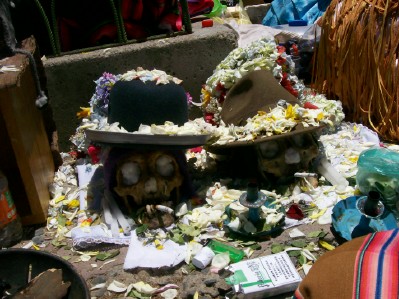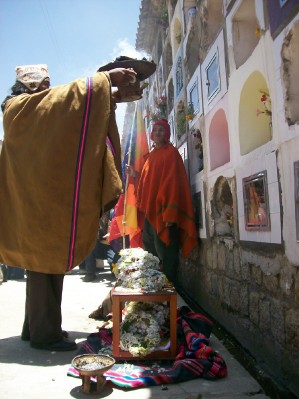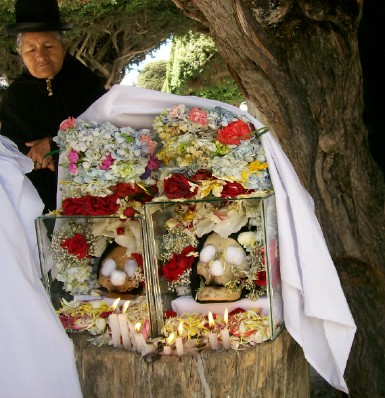Homemade shrines; boxes of glass or wood, wicker baskets and even cardboard boxes are used to carry the ñatita or the little skull to the main cemetery of the Bolivian capital, La Paz, on November 8 every year. Human skulls of all ages, from children to the elderly, are used in this ancient ceremony. Even before those carrying the skulls enter the gates of the cemetery, people start to gather round asking them questions, “What’s its name?” they ask someone with a ñatita in their arms. The names, like the age of the skull, vary: Cipriano, Sebastian, Cirilo, Gonzalo, José, Felipe, Juanita, Teresa.
The ñatita ceremony is celebrated throughout Bolivia with some areas enjoying large- scale parties. The ritual is an ancient tradition but has not always been popular, especially during periods when icons were prohibited. As Julia Sonco in her blog, Julita, [es] states,
Del origen de las ñatitas no se tiene un dato exacto, pero se conoce que datan de la época precolombina, dato que el amauta paceño, Sabino López, confirma con su relato de que antes que los conquistadores españoles pisaran tierra americana se veneraban a las “Chullpas”, que son los restos mortuorios de los curacas fallecidos, mismas que eran extraídas de sus mausoleos en los días de los difuntos y se les ofrecía la celebración.
But why take the skulls? Sabino López in Julita [es] says,
…el cráneo está relacionado con el “ajayu” (Palabra aymara que significa ánima, alma o espírtu). De acuerdo a la concepción andina que él tiene sobre el ritual de las ñatitas, la muerte del cuerpo no implica la muerte del ajayu al que se celebra con una K'oachada [una ceremonia ritual para las ñatitas] el día ocho del mes de noviembre.
In various places around the cemetery, at the foot of the skulls, are placed small ceramic incense burners where coal and incense are burnt as an offering. A table for the ritual is often specially prepared.
The blog, Religión [es], provides this information from an online radio [es] about the role skulls play in this celebration,
Las ñatitas son cráneos que representan deidades andinas a las que se les solicitan favores, algunas llevan nombres por la procedencia que tienen y otras son dotadas de seudónimos por las personas que la adoran.
“It’s called Teodorita,” says Mrs Pilar when asked about the name of the ñatita she is carrying. “It’s a girl,” she adds. “I have had her for seven years, she was a present,” she states.
In the blog, Fanbot, [es] the author quotes El Globo [es] to describe an event in the cemetery on November 8.
Una multitud de cráneos humanos adornados con flores eran bendecidos el lunes por un cura en un templo católico en un largo ritual ancestral que cada año cobra más vigor y cierra la festividad del Día de los Difuntos en este país de fuerte tradición andina.
On arriving to the cemetery in La Paz, many make straight for the chapel while others prefer to hold the ceremony in the grounds. Belief in the power of the ñatita to grant wishes leads to offerings being left to the skulls. Crowns of flowers, petals, candles, coca leaves and cigarettes are left by visitors to each shrine in the hope that their requests will be listened to.










